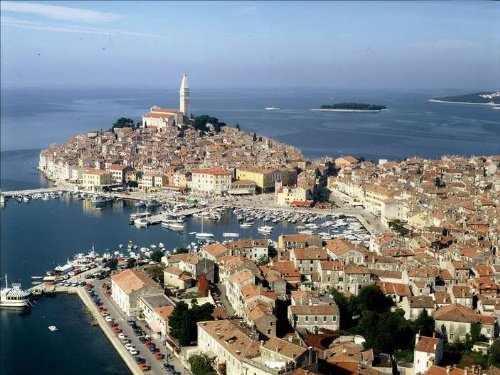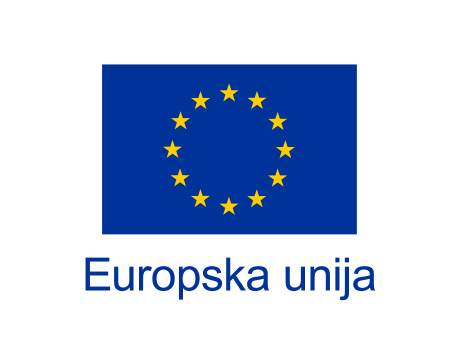Istria

Istria is the westernmost region of the Republic of Croatia, it is the largest peninsula of the Adriatic coast and occupies an area of about 2,900 km2. This region is unique and magnificent; it is surrounded by the Adriatic Sea which is deeply etched into the land with thousand lagoons and islands. Istria is easy reachable due to good road (regular bus lines), sea (regular ferry lines connect Istria with rest of Croatia and Italy, especially during the summer) and air (international airport Pula) connection with continental Croatia and with Europe, and the smaller villages are easy to find and to reach due to the good traffic connection in the region.
Traces of human life date from the prehistoric times (Sandalja Cave near Pula, Sandalja II, St. Romuald’s Cave in Lim Bay near Rovinj) and numerous cultures from the Roman time till today have left traces of their culture on this area. There are many valuable religious and architectural monuments that are preserved from all periods. If you are searching for old and hidden worlds, you will be enchanted by these: Pula (Amphitheatre, Golden Gate, Gate of Hercules, Austrian architecture buildings, Forum, The Temple, Flavia Street, Cathedral of Pula or Cathedral of the Assumption of the Blessed Virgin Mary), Labin (baroque palace Battiala-Lazzarini Palace, Porta Sanfioer), town Porec (Euphrasian Basilica, old town, Gothic Palace, Pentagonal tower, Public Square, Marafor Square, Great Temple, Matija Gubac Square), Funtana, town Rovinj (Church of St. Euphemia), Vrsar (abandoned stone quarries), Rabac, Savudrija and many others.
Istria is rich not only in culture but also in the geographical diversity, there are many gorgeous towns on the top of the hills in the inland, fertile fields, deep valleys, vineyards and olive groves on hillsides, mountains and a well indented coast by the clear sea. It is the largest green oasis of the North Adriatic with pine woods and green marquise on the coast and on the islands. There is the so called “white” (around the mountain peaks), “grey” (inner lands, land used for growing cereals and vegetables) and “red” (“terra rossa” or “crljenica” near the coast, lands used for cultivation of grapes, vine, olives and figs) Istria. The climate is Mediterranean with mild winters and warm summer days with a lot of moisture in the air especially in the coastal towns, the average sea temperature in March is 10°C and in August 24°C.
This area is rich in natural reservations and nature parks, which are legally protected landscapes with numerous plant species and diverse vegetation, which makes Istria the eco oasis in the heart of Europe. Natural attractions include: National Park Brijuni Islands; nature park: The mountain massif of Ucka; special reserves: Motovun Forest and Kontija Forest, The sea and sea bed of Lim Bay; forest parks: Zlatni rt, Sijana, Skaraba, Busoler, Kasteja Peninsula and Soline Hill near Vinkuran; protected landscapes: surroundings of Istarske toplice near Buzet, Lim Bay, Pazin abyss, Rovinj archipelago and coastal area, area of Gracisce - Pican, area around Labin, Rabac and Prklog Cove, upper and lower Kamenjak with Medulin archipelago and area of Ucka; zoological nature sight: Pincinova Cave; geomorphologic sights: Markova Cave, Podbaredine Cave, Vela Draga. The beaches are also a true wonder of nature; there are hidden coves with white pebbles, small and larger bays, rocky reefs and pure and intact nature beaches.
This region is the most famous and leading tourist region in Croatia. The vicinity to Europe, the good traffic connections and the rich offer makes it an old but still most wanted holiday resort. The polite inhabitants of the peninsula are dedicated to preserve the nature and they will allow you to enjoy in their paradise. Numerous hotels, camps and apartments provide a lovely stay for all guests. But as you can see on our web-site there are also many luxury private villas and houses providing you the complete privacy and relaxation in a quiet surrounding. The variety of touristic offer includes also yacht charter for a nice and adventurous cruising experience starting from Pula, Rovinj, Funtana or Vrsar.
Istrian cuisine is based on nature (aromatic spices, wild growing plants, vegetables, seafood) and is influenced with various traditions from the past. The characteristics of Istrian food are predominance of boiled over roast food, spices and wild growing plants, fish, vinegar and olive oil.
The climate, fresh air, non-polluted sea and good infrastructure allow athletes to practice in Istria throughout the year. In the vicinity of most of the hotels are sport grounds and all around Istria you will find many jogging, cross country tracks, bike trails, horseback riding tracks, facilities for extreme sports like paragliding and hang-gliding, free climbing, mountain running, mountain biking, caving, cannoning, parachuting. Throughout the year there are many sport events and tournaments held in Istria (sailing regattas – Brijuni regatta, Labin Republic Regatta, Regatta of boats with mainsail in Rovinj, Sailing Regatta in Umag, Istrian Regatta in Umag, Regatta Monfalcone-Umag-Monfalcone; bicycle races – Trophy of Porec Town, Istrian spring; swimming marathon – Porec Dolphin; tennis tournaments – Istrian Riviera a Porec, ATP Croatia Open Umag; boat races – Voga Teleferika in Rabac; Slovenian open championship in paragliding in Buzet; Croatian Open Hang-gliding Championship). Other events include rich offer in various cultural events – dance festivals (Salsa Latina Istriana in Pula, Summer Salsa Festival in Rovinj, World dance championship in Porec), folklore festivals (Fazana dance), wine and food exhibitions (Fazana's delights and delicacies, Vinisitra in Porec, Malvasia Wine festival in Porec, Days of asparagus in Umag), concerts and music festivals (Seasplash Reggae festival in Pula, Jazz festival: Jazz is Back in Groznjan), film festivals (Pula film festival, Motovun film festival, Casanova fest in Vrsar), theatre festivals (PUF International Alternative Theatre Festival in Pula, Street Art Festival in Porec), carnivals (Burning of the King Carnival in Buzet, Summer Carnival in Rabac), book fairs, flower shows…
Destinations
-
Istria
- - Bale
- - Barban
- - Barbici, Porec
- - Bartici, Labin
- - Blagari, Zminj
- - Brovinje, Labin
- - Dracevac
- - Drenje, Rasa
- - Duga Luka, Labin
- - Filipini, Porec
- - Galizana, Vodnjan
- - Gornje Baredine, Buje
- - Grzini, Zminj
- - Heraki, Sv. Lovrec
- - Islet Porer
- - Islet Sv. Ivan na pucini
- - Katun Boljunski
- - Klostar, Vrsar
- - Kozljak, Labin
- - Kranzeti, Umag
- - Kringa
- - Kukci, Porec
- - Limski kanal, Vrsar
- - Liznjan
- - Maklavun
- - Marasi
- - Materada, Umag
- - Medulin
- - Medvidici, Sv. Lovrec
- - Momjan, Buje
- - Montizana, Porec
- - Motovun
- - Muntic, Pula
- - Nedescina, Labin
- - Novigrad
- - Pacici, Svetvincenat
- - Pinezici, Pula
- - Pula
- - Punta, Buje
- - Puntera, Barban
- - Puntizela, Pula
- - Rakovci
- - Rebici, Marcana
- - Ribari, Mofardini
- - Ribari, Sveti Lovrec
- - Rogovici, Kastelir
- - Rovinjsko selo
- - Ruzici, Labin
- - Salakovci, Labin
- - Savudrija, Umag
- - Sisan, Pula
- - Skitaca, Labin
- - Skvaranska, Labin
- - Smolici, Visnjan
- - Stepancici, Labin
- - Stifanici, Baderna
- - Stinjan, Pula
- - Sv. Lovrec
- - Svetvincenat
- - Trget
- - Umag
- - Vabriga, Porec
- - Valbandon, Pula
- - Valica,Umag
- - Veznaveri, Porec
- - Viskovici, Labin
- - Vizinada
- - Vlakovo, Labin
- - Vodnjan
- - Vosteni, Sveti Lovrec
- - Vrecari, Labin
- - Zgrablici, Sv. Lovrec
- Kvarner & Primorje
- North Dalmatia
- Central Dalmatia
- South Dalmatia
- Bosnia and Herzegovina
















